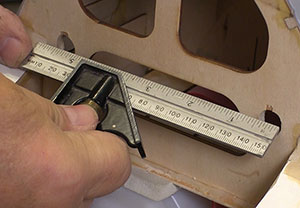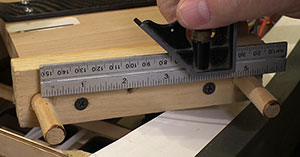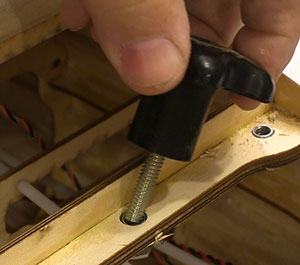Tom Hintz
50cc
[h=1]Warbird Ground Wheels[/h][h=2]Because the other wheels left with the wing[/h]Text, photos and video by Tom Hintz, flyingrc.net
Posted– 1-29-2016
There is an unwritten rule somewhere that requires warbirds to have retractable landing gear no matter what. While the wheels going up and down looks cool in the air taking the wing off to go home means your fancy plane has nothing to stand on. Worse, it won’t roll around easily in the shop or the field without the wing. In my shop and trailer airplane parking space is always hard to come by so I needed to figure out how to move my Top-Flite Giant Scale P47 Razorback around with the wing (and main wheels) removed.
[h=2]Cheap, Not Pretty[/h]I made the Warbird Ground Wheels featured in this story from scrap wood, a salvaged landing gear (the only thing to survive a major crash) and a pair of wheels I thought were too small for our grass runway but perfectly sized for this project. I expect that someone will make a high end Warbird Ground Wheels out of expensive wood and all tweaked out to look really cool. I had like 20 minutes to spare, my warbird is nearing completion and I needed a way to store it in the shop. I found a piece of ¾â€-thick plywood and a piece of poplar left over from some long-forgotten project. I even had a large enough piece of ½â€-diameter dowel stock.
[h=2]Assembly[/h]
I put the dowels that engage the wing retention dowel holes at the front of the wing pocket in a piece of poplar. I measured the layout of the wing dowel holes and used that dimension to lay out the hole locations on the poplar. And if you are trying to figure out how to measure the hole centers accurately, there is an easy way – don’t. Measure from the left edge of the left hole to the left edge of the right hole. Bingo, the exact distance between the hole centers unless the holes are different diameters. Use that dimension to lay out the dowel locations on the strip of wood and then glue in pieces of dowel that stick out about an inch. If the dowels are hard to get into the wing holes (as mine were) you might have to take a little material off the inside or outside of the pins depending on where the interference is. Any correction should be small so go slowly.
Next I found a piece of plywood that was as wide as the piece with the dowels in it and cut it so that it fit from the piece with the dowels back to the wing bolt support. Center the piece with the dowels in it on the main board and secure it with glue and screws.
I carefully drilled a 5/16â€-diameter hole through the plywood piece and through the wing bolt rail around its center. I decided against using the wing bolt blind nuts to eliminate the possibility of knocking one of the blind nuts loose or damaging those threads. Besides, one bolt is all we need to secure the Warbird Ground Wheels to the fuse. I installed the blind nut and pulled it into place being sure that its teeth are fully embedded in the wood.
All that remains is to install the landing gear. I put the gear a little ahead of the Top-Flite Giant Scale P47 Razorback spar location to be sure that the plane is not nose heavy on the Warbird Ground Wheels. The carbon fiber gear I used are overkill to be sure but they have been hanging around in my shop for some time so they were free and tall enough to keep the prop out of the dirt if I need to run the motor without the wing. I mounted the gear using simple wood screws through the existing mounting holes. There is no need to modify the gear so they remain available if I need them in the future. Putting some other gear on the Warbird Ground Wheels will be easy.
The Warbird Ground Wheels is a simple, cheap solution that can prevent expensive damage to a warbird or other plane that has its wheels mounted in the wing. The Warbird Ground Wheels can make it easier to transport your plane with less chance of “hangar rash†mysteriously appearing. Aside from potentially ruining a day at the field “hangar rash†can be expensive to repair so in that regard the Warbird Ground Wheelscan save money.
Posted– 1-29-2016
There is an unwritten rule somewhere that requires warbirds to have retractable landing gear no matter what. While the wheels going up and down looks cool in the air taking the wing off to go home means your fancy plane has nothing to stand on. Worse, it won’t roll around easily in the shop or the field without the wing. In my shop and trailer airplane parking space is always hard to come by so I needed to figure out how to move my Top-Flite Giant Scale P47 Razorback around with the wing (and main wheels) removed.
[h=2]Cheap, Not Pretty[/h]I made the Warbird Ground Wheels featured in this story from scrap wood, a salvaged landing gear (the only thing to survive a major crash) and a pair of wheels I thought were too small for our grass runway but perfectly sized for this project. I expect that someone will make a high end Warbird Ground Wheels out of expensive wood and all tweaked out to look really cool. I had like 20 minutes to spare, my warbird is nearing completion and I needed a way to store it in the shop. I found a piece of ¾â€-thick plywood and a piece of poplar left over from some long-forgotten project. I even had a large enough piece of ½â€-diameter dowel stock.
[h=2]Assembly[/h]

|

|
| To measure centers measure from the right edge of the right hole and the right edge of the left hole (left) that works out to be identical to the hole centers which you can then use to lay out where the holes go (right) on a piece of wood. Click images to enlarge | � |
Next I found a piece of plywood that was as wide as the piece with the dowels in it and cut it so that it fit from the piece with the dowels back to the wing bolt support. Center the piece with the dowels in it on the main board and secure it with glue and screws.
I carefully drilled a 5/16â€-diameter hole through the plywood piece and through the wing bolt rail around its center. I decided against using the wing bolt blind nuts to eliminate the possibility of knocking one of the blind nuts loose or damaging those threads. Besides, one bolt is all we need to secure the Warbird Ground Wheels to the fuse. I installed the blind nut and pulled it into place being sure that its teeth are fully embedded in the wood.
All that remains is to install the landing gear. I put the gear a little ahead of the Top-Flite Giant Scale P47 Razorback spar location to be sure that the plane is not nose heavy on the Warbird Ground Wheels. The carbon fiber gear I used are overkill to be sure but they have been hanging around in my shop for some time so they were free and tall enough to keep the prop out of the dirt if I need to run the motor without the wing. I mounted the gear using simple wood screws through the existing mounting holes. There is no need to modify the gear so they remain available if I need them in the future. Putting some other gear on the Warbird Ground Wheels will be easy.

| |
| To hold the Warbird Ground Wheels on I added a single 1/4-20 blind nut to the center of the support for the wing bolts. I got the knob at a woodworking store but you can find similar knobs at home centers etc. Click image to enlarge | � |
